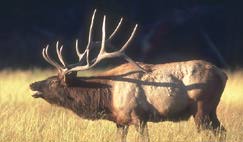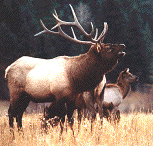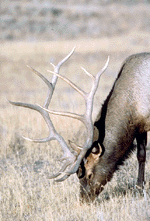
Information to help you locate Elk.

Elk habitat is composed of food, water, space, arrangement, and cover. Examples of cover are thermal cover, to stay warm and cool, escape cover, near cliffs or saddles, and at the end of drainage's, and loafing or resting cover, found in cool grassy areas. The time of year, time of day, and current weather conditions will dictate in which cover type elk may be found. Vegetative structure determines where elk can be found throughout the year. These are; willows and alders, found in drainages and wet sites, evergreen and pine provide escape cover, thermal cover and rub tree sites, aspen stands provide shade in the summer and food in the winter. Look for springs in these areas they can be heavy day long use areas by elk.
The aspect or direction that a mountain faces will largely determine temperature, snow depth, vegetative type, and during what seasons elk inhabit these areas. In early fall the typical elk migration would involve foraging on an open slope, or new aspen on the southeast face of a ridge. Usually upslope from a watering area used the night before. The elk will feed upward through the drainage reaching the saddle, or basin of the drainage by mid morning. Then will move over to a north or west face to them cool for the rest of the day. Here they would bed down to ruminate, or rechew the mornings feed, and await the reverse pattern in late afternoon.
The north face of a mountain will stays cool during the hotter months. The south face stays warm during the colder months. Winter range is typically south facing because the sun has melted the snow leaving grasses and shrubs open for foraging. Look for escape cover adjacent to south facing slopes for good winter range. Saddles provide good trails during seasonal and daily migration. They're sometimes found near ridges, cliffs and rock slides. Look to rock slides, cliffs and dark timber for good escape cover. Areas where various habitat components are in close proximity to each other are high use areas by elk. Here elk can move from cover type to cover type relatively easily during migration or pressure. Typical daily migration is upslope in the morning, and downslope in the evening. In the morning look to open grassy areas adjacent to aspen stands. Again, usually on the southeast face of a ridge. Look to wet areas and drainages for willow and alder. These are also places where springs and wallows can be found. By mid morning elk will be near escape and thermal cover found in saddles, ridges and north facing dark timber. Where they can stay cool during the hot afternoon. By late afternoon elk migrate in the reverse pattern.
Late in the Summer, in the high country, there usually no snow left on the peaks, however, during the season elk are growing their antlers, and they are covered with velvet, elk like to stay in the high country for a variety of reasons. One of the main reasons is the bull elk do not like to have a lot of flies and bugs around the velvet as it is very sensitive to that type of attack by different parasites. So they like to stay in the high country, clear up out of as many bugs as they can, where the temperatures are cool. The high country is an obvious place to start when it is still summer months, when there are not any deep snow depths, and the animals can move to those elevations. However, late in the summer as the grasses begin to dry up, and feed becomes less readily available in the high country, and the forage begins to burn off, the elk have to move out of those areas. They move down out of the high country, down into areas where there is moisture, down into the valley areas, ridge areas such as aspen ridges that still have plenty of vegetation. As the bigger summer herds are broken up, by competing bull elk, they move into smaller bunches of elk. Therefore, they need larger area in order to spread out, and they need different types of habitats. More feeding areas, more areas for resting in the afternoon, watering areas, wallow areas, rub areas. Places that the elk can use as escape cover. Cover that is actually designed by nature for animals to get away in. Aspen/Conifer mix areas are good for finding elk. They can lay down and hide in the areas and may never be seen. Make sure the areas have good escape cover.
After scouting an area, for example, if I wanted to look for elk early in the morning, and I had to ask myself, right now if I wanted to find an elk on that mountain, where would I go. The types of places you want to look early in the morning, start down in some the patches of aspen that are fringed by the open parks. Elk would be feeding in the open areas next to the aspen and then move into the dark timber on a north face. Going from feeding, watering areas into aspen areas where they can still feed only having a little move cover. Eventually moving into a dark timber are to then bed down by mid morning.
If it were late in the afternoon. Do pretty much the opposite. Places to start by mid afternoon would be in the dark timber moving very slow and quite. The elk will be getting up by late afternoon to start moving back into the feeding and watering areas. Pick the areas that contain the kind of areas the elk move through will increase your chances of success.
TIP: Hunt with the sun. In the morning when the sun is going up, hunt up. The primary reason for that is in the morning a downslope draft will be going down the mountain. Move in an upward direction. In the evening, hunt down the ridge. The air will be moving upslope, keep it in your face.
Elk have both daily and seasonal migration patterns. Elk migration daily patterns can help you locate Elk. Early in the morning when they are coming out of the early morning feeding areas and moving back into the timber where they have hiding cover and thermal cover from the day long temperatures. They will be moving up-slope mainly. Most of the feeding areas will be down-slope, there will be more grass in the lower areas. And elk will be moving up-slope into the timbered ridges. Moving from the south east ridges primarily to the north and west faces where its shadier, and they can hide from predators, and they can hide from man. They can sit on the ridge top and let the wind blow across their back and keep them cool. So, daily migration patterns are extremely important to keep in mind while hunting. Remember, that in the evening they will just do the reverse.
Afternoon ridges plays a really important part in the elk's daily migration and where your going to find them. In the early seasons, and in the first part of the rifle season in early October, the afternoon ridges are primarily used as escape cover. They will be on north faces, knife ridges, and normally in black timber. They will bed down in a nice cool shady spot, sometimes near water. They will lay there most of the afternoon, sometimes from mid morning to mid afternoon. Then they will get up and begin to feed back into the feeding areas.
Burn areas are good areas to look for elk. When the new plants and grasses grow they are high in protein and can cause elk to migrate towards them. Check for sign. Water may not be important as you would think. A lot of water is gained from the plants. In summer months look at the water sources for sign, but in latter you can not rely on the surface water spots.
Fall gathering areas are those areas where bulls and cows come together and form large herds. The cows are usually the ones that will designate these areas. The rank of dominance for the fall rut will occur in these areas. Historically they will use the same areas as the cows use for the spring calving areas. They have lush green areas with plenty of moisture, lots of feed, and a place where they have easy escape routes.
While you are scouting you need to be looking at these types of areas for the elk. You will need to know where these areas are, and be ready to be in them come the fall of the year. The gathering areas will usually be used from late August to mid September, the earlier part of the rut.
Within any area assumed to be a gathering area there are additional signs to look for when scouting for elk. These are signs of trails, tracks and scat. Signs that can alert you to the recent use of the area, heard composition and migration behavior.

For the most part cow elk determine when where the rut will take place. In the fall of the year cows will migrate to areas used for calving in the previous spring. Calving generally takes place in open aspen areas that are wet and cool. Areas with early growth for the calves to feed. When the rut takes place, is determined by the cows estrus cycle, usually in a peak between September 15th and October 15th. If the first peak cycle is missed, the bulls will get a another chance during the second estrus cycle, sometimes referred to as the second bugling peak.
Rut is the period that the rest of the years activity centers around. It is at this point in the life cycle when elk, especially bull elk, are the most vulnerable. In early fall of the year, bull elk are at extreme hormone levels, and are not as aware of danger. Their interests are in the confrontation with other bulls to gather cows for breeding, expending huge amounts of energy in the process. Once the rank of dominance is established, the larger bulls move off alone with their harem. While younger bulls move in to breed left over cows.
Cows determine when and where the rut takes place. Where, through previous calving areas. Again, these are wet open aspen areas with new growth. And when, by their estrus cycle, occurring between September 15th and October 15th.
Through the battle, a battle of endurance rather than death, the most genetically superior bulls will be selected to breed and continue the blood line.

Bugling by bull elk has several purposes. To locate other bulls for fighting, to keep cows away from other bulls, to locate cows and gathering harems, and to establish dominance, through loud aggressive calling. Telling other bulls to stay away. As a bull becomes older, the diameter of his wind pipe grows and has thicker walls. He has a larger chest area and lung capacity. Older age class bulls don't readily hit that three note scale, but more often end up with a one or two note bugle with a deep chested resonance sound to it. Different diameter grunt tubes can be used to mimic the size of a bull through bugling. When a rutting bull responds to the bugle of a hunter, he comes in to challenge, and expects the movement and smell of a bull ready to fight. The movement a hunter makes will not alarm the bull, as much as his smell. An elk can detect unnatural smells at long distances, with the help of a slight wind.
Bugling techniques and calling is another subject in itself, and could be best understood by reading books or watching videos on the subject. Check your local bookstore or library for additional reference material on bugling.
TIP: If your looking for bulls and your trying to bugle bulls, mimic what the elk are doing. If their not bugling, don't bugle.
Fresh tracks and scat can be vital information in determining where elk might be in a given migration pattern. It is at this point where all your knowledge comes into play. Look at the habitat. What is the vegetative structure, cover, mountain aspect, time of day, time of year? Form a strategy and know your opponents next move.
Fresh tracks contain the composition of elk in the area. Overall size is the main indicator of whether a track is from a bull, cow or calf. In a bull track, the toes point outward, while the toes in a cow or calf track point down and to the center in a curved fashion.
Wafered scat is from eating lush vegetation and therefore could be spring or summertime scat. During wintering, there is less moisture in vegetation so winter scat is round and pellet shaped.
 If antlers are developed, polished and shed at the correct time. If nutrition is good and stress is minimal. If good genetics are in the bulls blood line. And if a bull has reached a peak age class for antler growth, about seven to eleven years old, he has a good chance of growing a trophy quality set of antlers.
Each of the points along the main beam has a name. The first tines above the pedisel are called the eye guards, or the brow tines. The next set of tines are called the bez tines. Then the tre or tres tines. The dagger or the wolf tines are longer in length. These tines are used more in fighting or to jab or gouge when locked into another set of antlers. The fifth tine up is called the surroyal tine. Then the royal tine, sometimes referred to as the royal fork. The imperial tine, and the monarch. Tines that show maturity and dominance.
Whether a set of antlers are trophy quality or not is merely a subjective matter, based on an individuals opinion. To eleviate this subjectivity of a trophy class of a bull. A numbering system is available. This system is called the Boone and Crockett scoring system for rifle hunts and pickup antlers. And the Pope and Young scoring system for archery. Scoring a bull elks antlers is based on antler beam length and girth, point count, and length and width of the antler spread. Points are tallied for these categories. The Boone and Crockett club founded by Theodore Roosevelt, scored its first record in 1932. The current world record Rocky Mountain Elk was taken 1899, by John Plute of Crested Butte in dark canyon, Gunnison County, Colorado. The world record was officially scored 442 3/8 points, in 1961.
If antlers are developed, polished and shed at the correct time. If nutrition is good and stress is minimal. If good genetics are in the bulls blood line. And if a bull has reached a peak age class for antler growth, about seven to eleven years old, he has a good chance of growing a trophy quality set of antlers.
Each of the points along the main beam has a name. The first tines above the pedisel are called the eye guards, or the brow tines. The next set of tines are called the bez tines. Then the tre or tres tines. The dagger or the wolf tines are longer in length. These tines are used more in fighting or to jab or gouge when locked into another set of antlers. The fifth tine up is called the surroyal tine. Then the royal tine, sometimes referred to as the royal fork. The imperial tine, and the monarch. Tines that show maturity and dominance.
Whether a set of antlers are trophy quality or not is merely a subjective matter, based on an individuals opinion. To eleviate this subjectivity of a trophy class of a bull. A numbering system is available. This system is called the Boone and Crockett scoring system for rifle hunts and pickup antlers. And the Pope and Young scoring system for archery. Scoring a bull elks antlers is based on antler beam length and girth, point count, and length and width of the antler spread. Points are tallied for these categories. The Boone and Crockett club founded by Theodore Roosevelt, scored its first record in 1932. The current world record Rocky Mountain Elk was taken 1899, by John Plute of Crested Butte in dark canyon, Gunnison County, Colorado. The world record was officially scored 442 3/8 points, in 1961.


